To measure your digital transformation progress, companies must understand what Key Performance Indicators (KPIs) are important to measure.
A plethora of digital transformation KPIs are available online, ranging from concise “top 10” lists to extensive compilations like the “45 KPI list.” Custom KPIs tailored to specific projects further expand the array of available metrics.
Identifying the most crucial KPIs amidst this abundance is essential. The Digital Adoption research team consulted CIOs and IT leaders to pinpoint these vital metrics.
Our comprehensive list explains the significance of KPIs in comparison to other performance assessments and demonstrates their application in digital transformation endeavors.
Crucial digital transformation metrics include user experience, cost reduction, time-to-market, and customer satisfaction. These metrics serve as benchmarks for success, offering insights into the effectiveness of digital tools and areas for improvement. Monitoring overall user engagement, cost savings, and customer feedback enables organizations to gauge the success of their digital transformation initiatives accurately.
- What is a digital transformation KPI?
- What is the difference between digital transformation KPI & metric?
- Digital Transformation KPIs to Track your digital implementation journey
- Digital transformation KPIs that help us understand business outcomes
- Choosing The Right Digital Transformation KPIs
- How To Measure the Digital Transformation Progress
- Digital Transformation KPIs: What’s Next?
What is a digital transformation KPI?
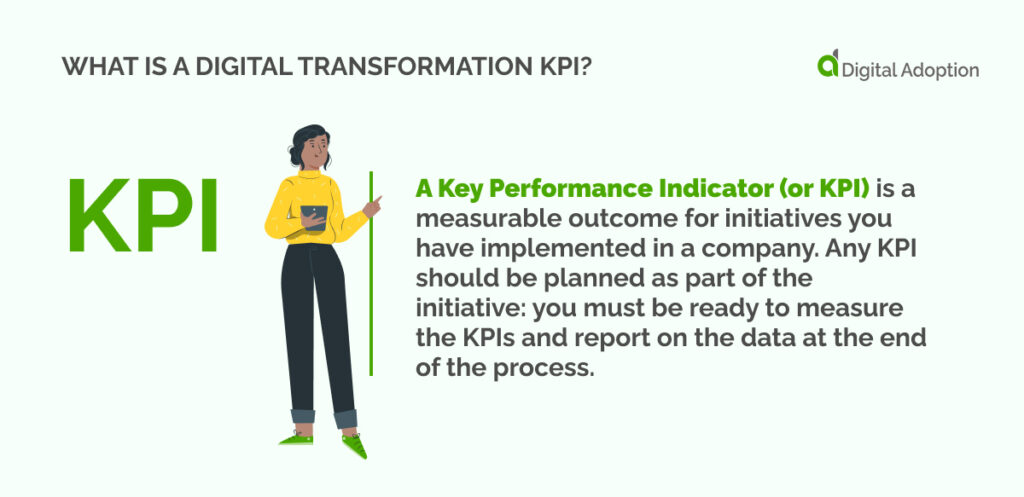
A Key Performance Indicator (or KPI) is a measurable outcome for initiatives you have implemented in a company. Any KPI should be planned as part of the initiative: you must be ready to measure the KPIs and report on the data at the end of the process.
Like any measure of organizational performance, digital transformation KPIs can be subjective and objective. They might measure activities within the company or with your clients, vendors, and suppliers. Some KPIs are very small, measuring the details of the project. Others are huge, measuring the overall financial benefits of the solution.
In this article, we’ve ended up with two separate lists of KPIs for digital transformation.
The first is digital transformation KPIs for infrastructure. (For most people, you’re most likely looking for this list). These KPIs inform you about your implementation and how well people use it. They will include a list of all the apps you’ve implemented, all the hardware you’ve bought, and all the development in the pipeline. It could also measure digital adoption, customer engagement, and employee productivity.
In addition, you should make sure that you also include business outcome KPIs. We need these KPIs because digital transformation is only partly about technology.
Fundamentally, digital transformation must generate business value. If digital solutions don’t make the company more efficient, productive, and cost-effective, there is no point in looking for adoption statistics or the number of licenses granted.
These factors may seem less connected with digital transformation, including agility, customer satisfaction, and ROI.
What is the difference between digital transformation KPI & metric?
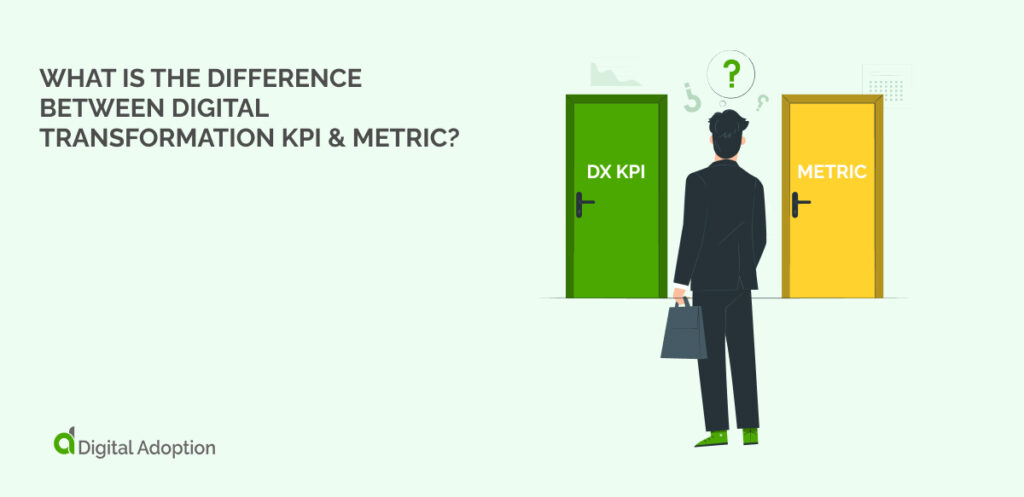
KPIs are only one measurement of performance. Other terms you might hear include:
- Results indicator
- Success Factor
- Performance Indicator
- Performance Metric
Conceptually, these are all very similar. However, KPIs are a much more important part of measuring a business model and performance. A KPI should be:
- critical to business success
- strategically aligned with business plans
- Highly relevant to the business.
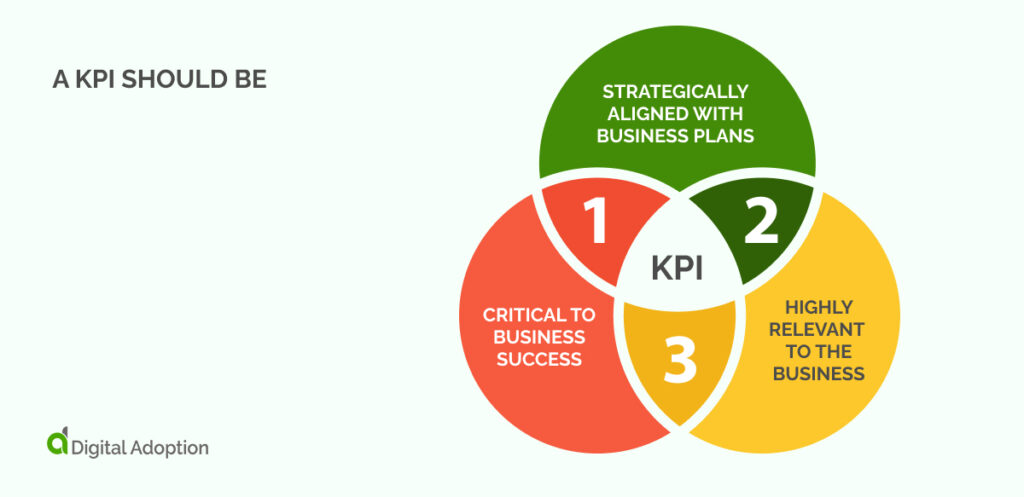
By contrast, other performance metrics are not critical to business success.. So, for individual staff performance, we might use performance measures to assess individual staff performance. But this wouldn’t be a KPI!
Digital Transformation KPIs to Track your digital implementation journey
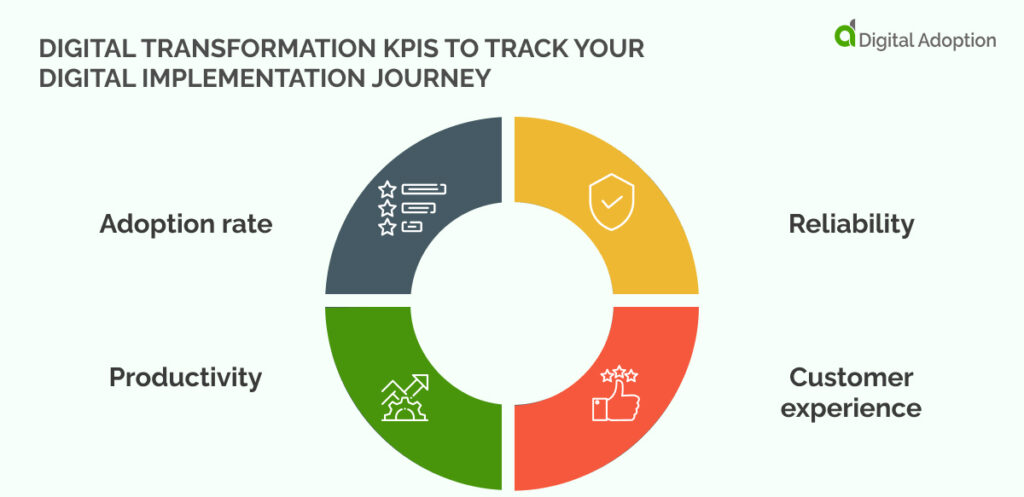
Let’s imagine you’ve started a new digital transformation project.
The impact of the project could be very visible. If you change the customer journey, procurement processes, or inventory management, you will know quickly if the digital transformation plan works well. In this case, KPIs will help to quantify the project’s success. With good outcomes for the KPIs, all stakeholders can be pleased with the project’s progress.
On the other hand, some processes will be difficult to see. Perhaps the administrative staff is completing tasks differently. Or they use a new documentation system to manage new hires. The leadership team will not see the problems and success so clearly for these changes. It is even more important to decide on good KPIs, collect appropriate data, and understand the impact of the project.
You should measure success of your digital infrastructure project using the following broad KPIs. They will show whether the DX project has been effective – and prove to stakeholders that the change leaders are investing wisely.
- Adoption rate
How many people are using the new system? This is essential information. Performance assessment is irrelevant if you don’t have a good adoption.
You may measure the percentage of employees who have adopted the new digital service. This can give you an overall sense of how well employees receive the service.
Alternatively, the number of daily active users could be a better measure for adoption. This KPI measures the number of employees actively using the new digital service regularly.
A proxy for adoption is the Completion Rate. This KPI measures the percentage of employees who have completed all necessary training or onboarding related to the new digital service. This can indicate how well employees adapt to the new system and whether additional support or training may be needed.
A digital adoption platform can be very helpful for these measures. It can gather all kinds of data to support your progress.
- Productivity
So now, let’s assume that lots of staff are using the new digital system. That’s great, right?
Not quite. Adoption is only good when it makes staff more productive. And for this metric, strategy is very important. After all, productivity is a very subject concept. Moreover, you must understand the changes in productivity before, during, and after the implementation project.
Are you interested in how much time each user spends on a task? Are you interested in the number of tasks they complete in a day? Are you interested in each task’s accuracy, compliance, and competence? Do you want to know the completion time of each process? Or perhaps you want to take a longer-term view and gather information about employee satisfaction with their work.
Any of these KPIs could be important for your company.
- Reliability
Measuring reliability is relevant if the DX project is going well or badly.
In one case, the DX project is going well. Adoption rates are high. Productivity is up. That’s great! But before you celebrate, take a look at reliability metrics. If the systems are unreliable, then there is room for improvement.
In another case, the DX project is going badly. No one wants to use the software, and all your internal processes are slower than before. What’s the problem? You have one area to work on if the systems aren’t functioning properly.
Some of the specific proxies you can use for reliability include:
- Uptime. Uptime is a key indicator of reliability, as it ensures that users can access the system when needed and that business processes are not disrupted due to system downtime.
- Mean time between failure (MTBF). This KPI measures the average time between system failures. A higher MTBF indicates that the system is less likely to fail, which can increase confidence in the system’s reliability.
- Mean time to repair. This KPI measures the average time to fix a system or infrastructure failure. A lower MTTR indicates that the system is more reliable, as failures can be quickly repaired and business processes can resume without significant downtime.
- Error Rate: This KPI measures the number of errors or defects in the system or digital infrastructure. A higher error rate can indicate that the system is less reliable and may require additional testing or improvements to increase reliability.
- Customer experience
Customer experience is a useful set of KPIs that links with the long-term potential of digital investments. There are various ways to measure customer experience, including subjective and objective measures.
Subjective measures can be determined by evaluating whether customers prefer digital solutions over previous methods or are willing to recommend the service.
Objective measures, such as the percentage of transactions conducted online, the speed of commerce, and the abandon rate for e-commerce transactions, can provide insight into how digital solutions are adopted.
Additionally, tracking metrics like customer spend and cost per transaction can give a more comprehensive view of the impact of digital transformation investments.
Understanding the customer experience gives an insight into the long-term potential of your digital investments. It’s not the whole story but it will link to the ROI.
Digital transformation KPIs that help us understand business outcomes
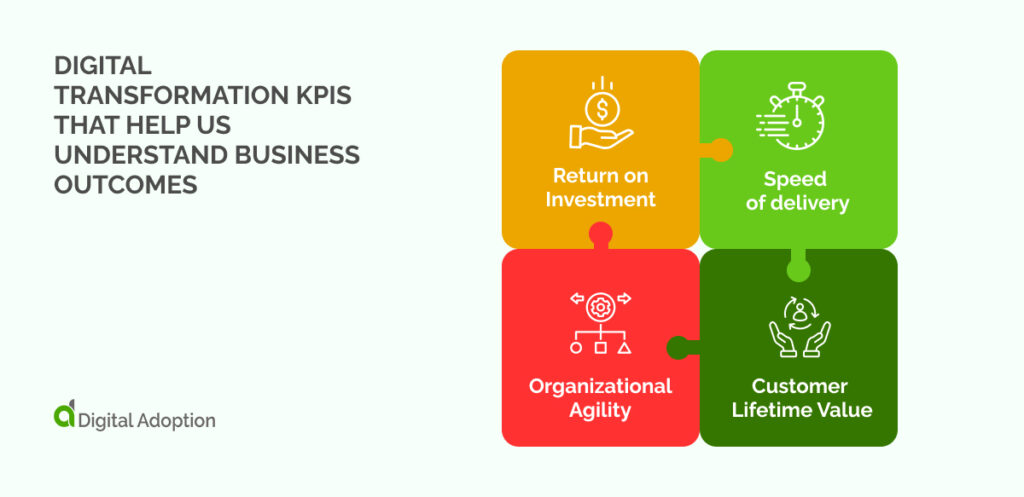
There is another level of digital transformation KPIs.
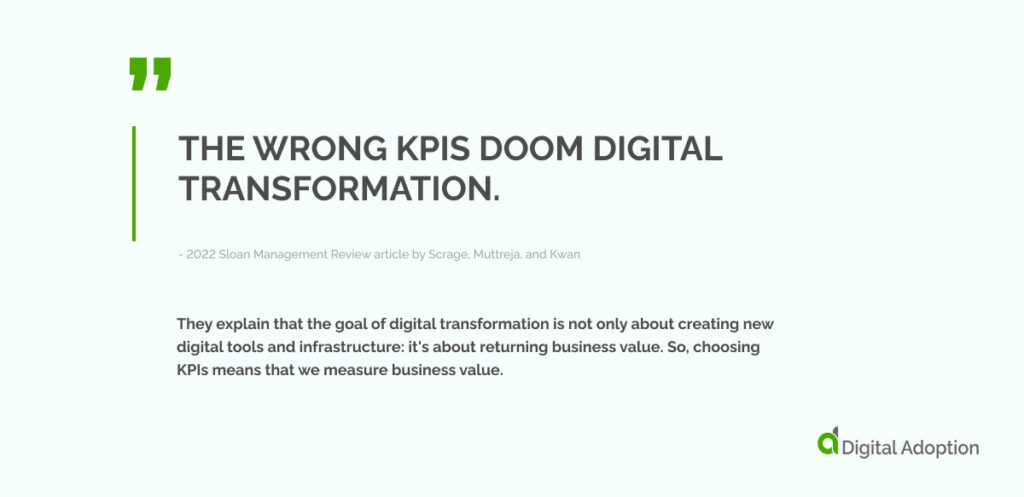
A 2022 Sloan Management Review article by Scrage, Muttreja, and Kwan argued that “the Wrong KPIs Doom Digital Transformation.” They explain that the goal of digital transformation is not only about creating new digital tools and infrastructure: it’s about returning business value. So, choosing KPIs means that we measure business value.
Of course, measuring your digital capabilities and infrastructure is still important. You need to know if your digital solutions are working or not. But to take your DX to the next level, you must assess the business impact. We suggest the following KPIs for this purpose.
Return on Investment
The ROI on your digital investments is a simple but effective measure of success. In a large-scale implementation project, it may be difficult to track everything at once. Measuring the ROI in detail as the project proceeds is a practical approach.
Speed of delivery.
The speed of delivery is a crucial measure of digital transformation success. This metric is a good measure for upper leaders and a proxy measure of employee experience. Agile methodologies can significantly improve this, making it a vital indicator of digital maturity. In today’s fast-paced business environment, digitally mature organizations are better at creating new solutions, particularly from emergent technology.
Organizational Agility
Today’s digital companies aren’t about compliance with established processes. After all, many digital systems mean compliance is built into the process. But how quickly can your designs respond to sudden changes and requests? This could come down to some extremely granular measurable information.
Customer Lifetime Value
Customer Lifetime Value (CLV) is the total revenue a customer generates for a business over their whole relationship. CLV considers various factors, such as the customer’s purchasing patterns, frequency of transactions, average order value, and the estimated length of the relationship.
CLV helps leaders focus on the positive impacts of digital transformation and business outcomes rather than just customer satisfaction.
Choosing The Right Digital Transformation KPIs

Now that we know all the important KPIs – how do you know which ones to use? Should we focus on all the KPIs discussed in this article? You need to be selective. Every company must decide its digital transformation KPIs from its strategic planning.
If we don’t know what we started with, we won’t know what improvements have been created. As a recent McKinsey article explained, it is crucial to prioritize your goals. If you know what outcomes you want, it’s much easier to make quick decisions later on.
Moreover, there is another complication: who will use the KPIs? Each stakeholder will need different results. So, it’s essential to think about the audience. For example, a CEO may need information on the new digital experts the company has hired or the percentage of a budget allocated for digital innovation. But boardroom stakeholders will be more interested in the overall ROI of digital initiatives.
You will likely need a portfolio of KPIs to help understand successful digital transformation.
How To Measure the Digital Transformation Progress
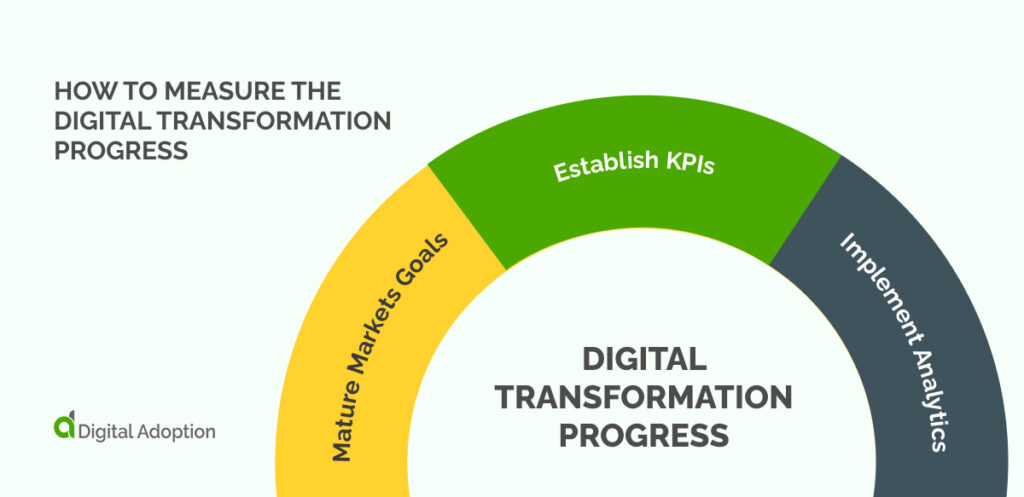
You should get ready to measure digital transformation from the beginning of planning. You must choose the right KPIs, develop methods to gather the right data, and review the outcomes regularly. Take the following three steps to make sure that the outcome is effective:
- Set Goals. Before starting any digital transformation project, setting clear business goals is crucial. These goals should be aligned with your organization’s overall strategy and objectives. Setting specific and measurable goals allows you to track your progress and determine whether your digital transformation efforts are successful.
- Establish KPIs. Once you have set your business goals, you need to establish KPIs to help you measure progress. KPIs should be specific, measurable, and relevant to your audience.
- Implement Analytics. You must implement analytics tools to measure progress against your established KPIs. These tools can help you collect and analyze data, track performance, and identify areas for improvement. By using analytics, you can gain valuable insights into the effectiveness of your digital transformation initiatives and make data-driven decisions.
In summary, by setting clear goals, establishing relevant KPIs, and implementing analytics tools, you can measure the success of your digital transformation project and make data-driven decisions to improve your business outcomes.
Digital Transformation KPIs: What’s Next?
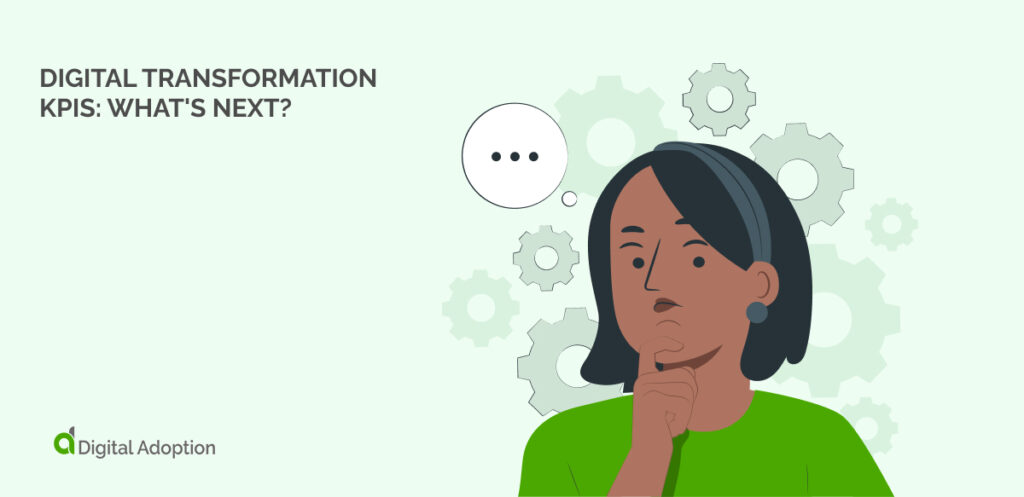
In the years ahead, digital transformation KPIs will become increasingly important. As businesses progress toward digitization and automation of their operations, measuring progress in digital KPIs will become an essential tool for tracking and understanding the success of a transformation initiative.
By now, it should be clear that KPIs are essential for understanding the progress of a digital transformation project. You’ll never know whether your project returns useful outcomes if you don’t have good KPIs.
Your choice of KPI will be different according to industry, geography, size of the organization, and many other factors. In this article, we’ve covered some crucial areas of digital infrastructure and business outcomes. But before deciding on the final KPIs for your project, it is worth discussing your business with an expert in the field.

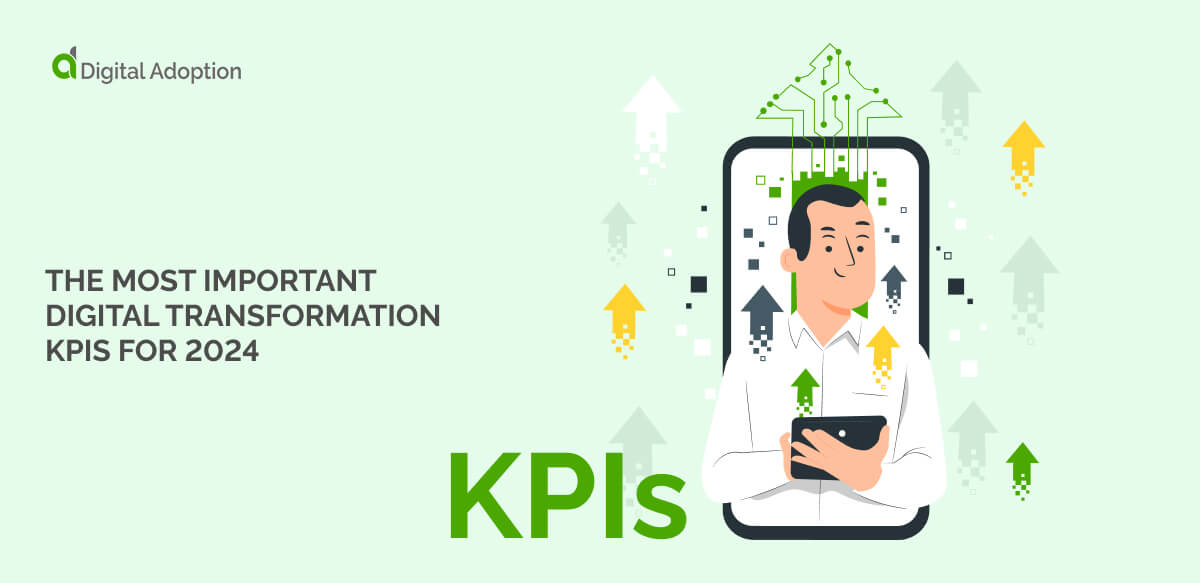


![4 Best AI Chatbots for eCommerce [2025]](https://www.digital-adoption.com/wp-content/uploads/2025/03/4-Best-AI-Chatbots-for-eCommerce-2025-img-300x146.jpg)


![13 Digital Transformation Enablers [2025]](https://www.digital-adoption.com/wp-content/uploads/2025/02/13-Digital-Transformation-Enablers-2025-img-300x146.jpg)



![4 Best AI Chatbots for eCommerce [2025]](https://www.digital-adoption.com/wp-content/uploads/2025/03/4-Best-AI-Chatbots-for-eCommerce-2025-img.jpg)

